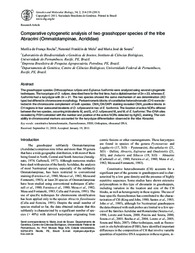Comparative cytogenetic analysis of two grasshopper species of the tribe Abracrini (Ommatolampinae, Acrididae).
Comparative cytogenetic analysis of two grasshopper species of the tribe Abracrini (Ommatolampinae, Acrididae).
Author(s): ROCHA, M. de F.; MELO, N. F. de; SOUZA, M. J. de
Summary: The grasshopper species Orthoscapheus rufipes and Eujivarus fusiformis were analyzed using several cytogenetic techniques. The karyotype of O. rufipes, described here for the first time, had a diploid number of 2n = 23, whereasE. fusiformis had a karyotype with 2n = 21. The two species showed the same mechanism of sex determination (XO type) but differed in chromosome morphology. Pericentromeric blocks of constitutive heterochromatin (CH) were de- tected in the chromosome complement of both species. CMA3 /DA/DAPI staining revealed CMA3 -positive blocks in CH regions in four autosomal bivalents of O. rufipes and in two of E. fusiformis. The location of active NORs differed between the two species, occurring in bivalents M6 and S9 of O. rufipes and M6 and M7 of E. fusiformsi. The rDNA sites revealed by FISH coincided with the number and position of the active NORs detected by AgNO 3 staining. The vari- ability in chromosomal markers accounted for the karyotype differentiation observed in the tribe Abracrini.
Publication year: 2011
Types of publication: Journal article
Unit: Embrapa Semi-arid Region
Observation
Some of Embrapa's publications are published as ePub files. To read them, use or download one of the following free software options to your computer or mobile device. Android: Google Play Books; IOS: iBooks; Windows and Linux: Calibre.
Access other publications
Access the Agricultural Research Database (BDPA) to consult Embrapa's full library collection and records.
Visit Embrapa Bookstore to purchase books and other publications sold by Embrapa.

